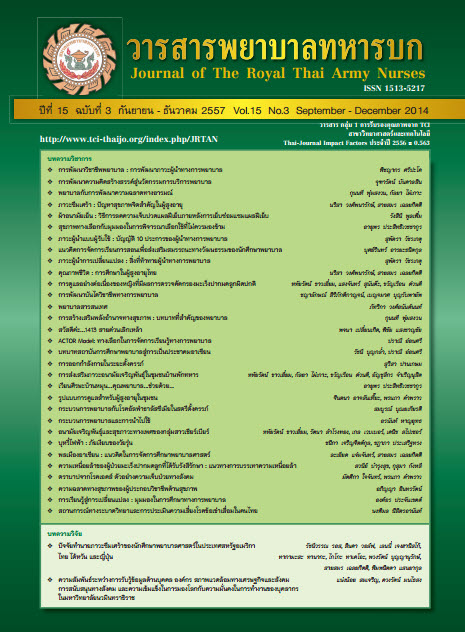ผลของการใช้รูปแบบการเฝ้าระวังการติดเชื้อต่อประสิทธิภาพการเฝ้าระวัง การติดเชื้อทางเดินปัสสาวะและจำนวนวันนอนของผู้ป่วย
Keywords:
รูปแบบการเฝ้าระวังการติดเชื้อ, ประสิทธิภาพการเฝ้าระวังการติดเชื้อทางเดินปัสสาวะ, จำนวนวันนอนของผู้ป่วย, Infection surveillance model, Effiiency of urinary tract infection surveillance, Length of stayAbstract
การวิจัยครั้งนี้มีวัตถุประสงค์ 1) ศึกษาประสิทธิภาพการเฝ้าระวังการติดเชื้อทางเดินปัสสาวะของพยาบาลควบคุมการติดเชื้อประจำหอผู้ป่วยหลังการใช้รูปแบบการเฝ้าระวังการติดเชื้อ 2) เปรียบเทียบจำนวนวันนอนของผู้ป่วยก่อนและหลังการใช้รูปแบบการเฝ้าระวังการติดเชื้อ และ 3) เปรียบเทียบประสิทธิภาพการเฝ้าระวังการติดเชื้อทางเดินปัสสาวะหลังการใช้รูปแบบการเฝ้าระวังการติดเชื้อเดือนที่ 1 และเดือนที่ 2 กลุ่มตัวอย่าง คือ พยาบาลควบคุมการติดเชื้อประจำหอผู้ป่วย จำนวน 10 คน และผู้ป่วยที่ได้รับการดูแลจากพยาบาลควบคุมการติดเชื้อประจำหอผู้ป่วย จำนวน 30 คน เครื่องมือการวิจัย มีดังนี้ รูปแบบการเฝ้าระวังการติดเชื้อแบบวัดความรู้แบบบันทึกแบบประเมินประสิทธิภาพการเฝ้าระวังการติดเชื้อและแบบบันทึกจำนวนวันนอนของผู้ป่วยผ่านการตรวจสอบความตรงตามเนื้อหา และผ่านการทดสอบความเที่ยงโดยใช้สถิติ KR 20 เท่ากับ .91 วิเคราะห์ข้อมูลโดยสถิตินอนพาราเมตริกทดสอบโดยใช้เครื่องหมาย (Sign test) ผลการวิจัย พบว่า ประสิทธิภาพการเฝ้าระวังการติดเชื้อทางเดินปัสสาวะของพยาบาลควบคุมการติดเชื้อประจำหอผู้ป่วยหลังการใช้รูปแบบการเฝ้าระวังการติดเชื้อเดือนที่ 1 และเดือนที่ 2 อยู่ในระดับดีและไม่แตกต่างกัน ส่วนจำนวนวันนอนของผู้ป่วยภายหลังการใช้รูปแบบการเฝ้าระวังการติดเชื้อลดลง อย่างมีนัยสำคัญทางสถิติที่ระดับ .05
The purposes of this research were to: 1) assess the effiiency of urinary tract infection surveillance by the Infection Control Ward Nurses (ICWNs) using the infection surveillance model, 2) compare the length of stay of patients before and after using infection surveillance model, and 3) compare the effiiency of urinary tract infection surveillance after using infection surveillance model for the fist and the second month. The study population comprised of 10 ICWNs and 30 patients was care by ICWNs.The research instruments were developed by the researcher and consisted of: Training project of Infection surveillance model, Infection surveillance model, Knowledge test of urinary tract infection surveillance, Recording form of urinary tract infection surveillance, Evaluation form of the effiiency of urinary tract infection surveillance and Length of stay record. All instruments were tested for content validity and the reliability of the questionnaires was. 91 testing by Kuder Richardson formula 20. The data were analyzed by using sign test. The major fidings were as follows: The effiiency of urinary tract infection surveillance by Infection Control Ward Nurses (ICWNs) who routinely used the infection surveillance model after one month and two month periods was good and consistent. The effiiency of urinary tract infection surveillance using the infection surveillance model after one month and two month periods wasthe same. After using the infection surveillance model, the length of stay was signifiantly decreased at .05 level.
Downloads
Downloads
How to Cite
Issue
Section
License
บทความหรือข้อคิดเห็นใดใดที่ปรากฏในวารสารพยาบาลทหารบกเป็นวรรณกรรมของผู้เขียน ซึ่งบรรณาธิการหรือสมาคมพยาบาลทหารบก ไม่จำเป็นต้องเห็นด้วย
บทความที่ได้รับการตีพิมพ์เป็นลิขสิทธิ์ของวารสารพยาบาลทหารบก
The ideas and opinions expressed in the Journal of The Royal Thai Army Nurses are those of the authors and not necessarily those
of the editor or Royal Thai Army Nurses Association.






